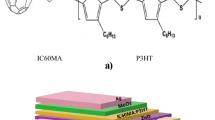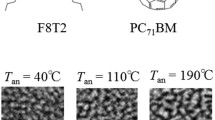Abstract
The diffusion of constituent materials at interfaces is one of the key factors for device performance and stability. In this work, the effect of interfacial diffusion of a classic interfacial material PFN on device performance of polymer solar cells was studied quantitatively by doping PFN into active layer based on P3HT:PC61BM blend. The PCEs of devices with 550 ppm PFN decrease to half compared to those of the control devices without PFN, which are mainly attributed to the decrease of short-circuit current (J sc) and fill factor (FF). Advanced analyses of equivalent circuit, absorption spectra, and atomic force microscopy indicates that the presence of PFN in the active layer increases the leakage current, decreases the aggregation of P3HT, and reduces the phase separation. This research reveals the physical mechanism of interfacial diffusion in device performance and provides a basis for further improving the performance and stability of PSCs.
Similar content being viewed by others
References
Chen JW, Cao Y. Development of novel conjugated donor polymers for high-efficiency bulk-heterojunction photovoltaic devices. Acc Chem Res, 2009, 42: 1709–1718
Cheng YJ, Yang SH, Hsu CS. Synthesis of conjugated polymers for organic solar cell applications. Chem Rev, 2009, 109: 5868–5923
Li G, Zhu R, Yang Y. Polymer solar cells. Nat Photonics, 2012, 6: 153–161
Li YF. Molecular design of photovoltaic materials for polymer solar cells: toward suitable electronic energy levels and broad absorption. Acc Chem Res, 2012, 45: 723–733
He Z, Zhong C, Su S, Xu M, Wu H, Cao Y. Enhanced power-conversion efficiency in polymer solar cells using an inverted device structure. Nat Photonics, 2012, 6: 591–595
Gu C, Chen Y, Zhang Z, Xue S, Sun S, Zhang K, Zhong C, Zhang H, Oan Y, Lv Y, Yang Ym Li F, Zhang S, Huang F, Ma Y. Electrochemical route to fabricate film-like congjugated microporous polymers and application for organic electronics. Adv Mater, 2013, 25: 3443–3448
Gao L, Zhang J, He C, Zhang Y, Sun QJ, Li YF. Effect of additives on the photovoltaic properties of organic solar cells based on triphenylamine-containing amorphous molecules. Sci China Chem, 2014, 57: 966–972
Liu X, Cai P, Chen DC, Chen JW, Su SJ, Cao Y. Small molecular non-fullerene electron acceptors for P3HT-based bulk-heterojunction solar cells. Sci China Chem, 2014, 57: 973–981
Dou L, You J, Yang J, Chen C-C, He Y, Murase S, Moriarty T, Emery K, Li G, Yang Y. Tandem polymer solar cells featuring a spectrally matched low-bandgap polymer. Nat Photonics, 2012, 6: 180–185
Jørgensen M, Norrman K, Gevorgyan S A, Tromholy T, Andreasen B, Krebs F C. Stability of polymer solar cells. Adv Mater, 2012, 24: 580–612
Cao H, He W, Mao Y, Lin X, Ishikawa K, Dickerson J H, Hess W P. Recent progress in degradation and stabilization of organic solar cells. J Power Sources, 2014, 264: 168–183
Jørgensen M, Norrman K, Krebs FC. Stability/degradation of polymer solar cells. Sol Energy Mater Sol Cells, 2008, 92: 686–714
Norrman K, Gevorgyan S A, Krebs F C. Water-induced degradation of polymer solar cells studied by H218O labeling. ACS Appl Mater Interfaces, 2009, 1: 102–112
Jeon S O, Lee J Y. Improved lifetime in organic solar cells using a bilayer cathode of organic interlayer/Al. Sol Energy Mater Sol Cells, 2012, 101, 160–165
Motaung D E, Malgas G F, Arendse C J. Insights into the stability and thermal degradation of P3HT: C60 blended films for solar cell applications. J Mater Sci, 2011, 46: 4942–4952
Andersen M, Carle J E, Cruys-Bagger N, Lilliedal M R, M. Ham-mond A, Winther-Jensn B, Krebs F. C. Transparent anodes for polymer photovoltaics: oxygen permeability of PEDOT. Sol Energy Mater Sol Cells, 2007, 91: 539–543
Huang F, Wu H, Wang D, Yang W, Cao Y. Novel electroluminescent conjugated polyelectrolytes based on polyfluorene. Chem Mater, 2004, 16: 708–716
Lv M, Li S, Jasieniak J J, Hou J, Zhu J, Tan Z, Watkins S E, Li Y, Chen X. A hyperbranched conjugated polymer as the cathode interlayer for high performance polymer solar cells. Adv Mater, 2013, 25: 6889–6894
He Z, Zhong C, Huang X, Wong W Y, Wu H, Chen L, Su S, Cao Y. Simultaneous enhancement of open-circuit voltage short-circuit current density, and fill factor in polymer solar cells. Adv Mater, 2011, 23: 4636–4643
Yip H L, Jen A K. Recent advances in solution-processed interfacial materials for efficient and stable polymer solar cells. Energy Environ Sci, 2012, 5, 5994–6011
Dang M T, Wantz G, Bejbouji H, Urien M, Dautel O J, Vignau L, Hirsch L. Polymeric solar cells based on P3HT:PC61BM: Role of the casting solvent. Sol Energ Mat Sol C, 2011, 95: 3408–3418
Duan C, Cai W, Ben B Y, Zhong C, Zhang K, Liu C, Hu Z, Huang F, C. Bazan G, J. Heeger A, Cao Y. Toward green solvent processable photovoltaic materials for polymer solar cells: the role of highly polar pendant groups in charge carrier transport and photovoltaic behavior. Energy Environ Sci, 2013, 6, 3022–3034
Ma D, Lv M, Lei M, Zhu J, Wang H, Chen X. Self-organization of amine-based cathode interfacial materials in inverted polymer solar cells. ACS Nano, 2014, 8, 1601–1608
Dang M T, Hirsch L, Wantz G, Wuest JD. Controlling the morphology and performance of bulk heterojunctions in solar cells. Lessons learned from the benchmark poly(3-hexylthiophene):[6, 6]-phenyl-C61-butyric acid methanol ester system. Chem Rev, 2013, 113: 3734–3765
Milton J. Rosen Joy T. Kunjappu. Surfactants and Interfacial Phenomena (4th. ed.). New York: Wiley, 2012
Author information
Authors and Affiliations
Corresponding authors
Rights and permissions
About this article
Cite this article
Nian, L., Zhou, J., Zeng, K. et al. The effect of interfacial diffusion on device performance of polymer solar cells: a quantitative view by active-layer doping. Sci. China Chem. 58, 317–322 (2015). https://doi.org/10.1007/s11426-014-5222-8
Received:
Accepted:
Published:
Issue Date:
DOI: https://doi.org/10.1007/s11426-014-5222-8




